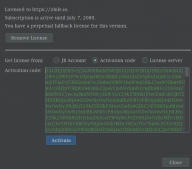问题产生描述
使用子进程处理一个大的日志文件,并对文件进行分析查询,需要等待子进程执行的输出结果,进行下一步处理。
出问题的代码
|
1
2
3
4
5
6
7
8
9
10
11
12
13
14
15
16
17
18
|
# 启用子进程执行外部shell命令def __subprocess(self,cmd): try: # 执行外部shell命令, 输出结果输出管道 p = subprocess.Popen(cmd, shell=True, stdout=subprocess.PIPE, stderr=subprocess.STDOUT) p.wait() # 从标准输出读出shell命令的输出结果 #rt = p.stdout.read().decode() # 以换行符拆分数据,并去掉换行符号存入列表 rt_list = rt.strip().split('\n') except Exception as e: if(DEBUG): print(traceback.format_exc()) return rt_list |
问题分析
子进程产生一些数据,他们会被buffer起来,当buffer满了,会写到子进程的标准输出和标准错误输出,这些东西通过管道发送给父进程。当管道满了之后,子进程就停止写入,于是就卡住了,及时取走管道的输出就不会出现阻塞了
但是本人此处采取的是临时文件接收子进程输出,由于临时文件是建立在磁盘上的,没有size的限制,并且文件被close后,相应的磁盘上的空间也会被释放掉。
已改进的代码
|
1
2
3
4
5
6
7
8
9
10
11
12
13
14
15
16
17
18
19
20
21
22
23
24
25
26
27
28
29
|
import tempfile# 启用子进程执行外部shell命令def __subprocess(self,cmd): try: # 得到一个临时文件对象, 调用close后,此文件从磁盘删除 out_temp = tempfile.TemporaryFile(mode='w+') # 获取临时文件的文件号 fileno = out_temp.fileno() # 执行外部shell命令, 输出结果存入临时文件中 p = subprocess.Popen(cmd, shell=True, stdout=fileno, stderr=fileno) p.wait() # 从临时文件读出shell命令的输出结果 out_temp.seek(0) rt = out_temp.read() # 以换行符拆分数据,并去掉换行符号存入列表 rt_list = rt.strip().split('\n') except Exception as e: if(DEBUG): print(traceback.format_exc()) finally: if out_temp: out_temp.close() return rt_list |
以上这篇对Python subprocess.Popen子进程管道阻塞详解就是小编分享给大家的全部内容了,希望能给大家一个参考,也希望大家多多支持服务器之家。
原文链接:https://blog.csdn.net/u010649766/article/details/75573887





